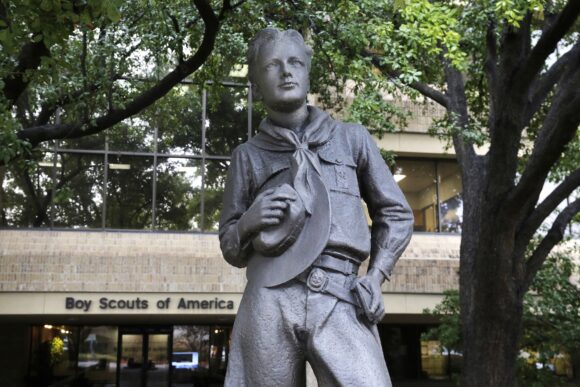DOVER, Del. (AP) — A Delaware bankruptcy judge has approved parts of the Boy Scouts of America’s reorganization plan but has rejected other provisions, saying in a ruling Friday that the organization has “decisions to make” regarding the plan.
Judge Laurie Selber Silverstein issued her 281-page ruling, months after concluding a trial in the case. She indicated that she is willing to hold a status conference upon a request by attorneys for the Boy Scouts.
The BSA’s plan proposed the creation of a $2.6 billion fund to compensate tens of thousands of men who say they were sexually abused as children involved in Scouting, while maintaining the organization’s financial ability to continue operating.
The ruling is the just latest example of uncertainty in a case that has seen myriad twists and turns since the Boy Scouts sought bankruptcy protection more than two years ago to stave off a flood of lawsuits alleging child sexual abuse by Scout leaders and volunteers.
In the meantime, the cash-strapped BSA has spent more than $327 million in fees and expenses in the bankruptcy and continues to bleed money, with no end in sight. It also remains unclear when any of the 82,000 sexual abuse claimants in the bankruptcy might receive any compensation for their abuse.
The plan called for the Irving, Texas-based BSA and its local councils, along with settling insurance companies and troop sponsoring organizations, to contribute some $2.6 billion in cash and property to a fund for abuse claimants. In return for those contributions, those entities would be shielded from future lawsuits over Scout-related abuse.
When it filed for bankruptcy, the BSA faced about 275 filed lawsuits and was aware of roughly another 1,400 potential cases, but more than 82,200 abuse claims were filed in the bankruptcy. Attorneys for BSA insurers argued early on that the sheer volume of claims was an indication of fraud and the result of aggressive client solicitation by attorneys and for-profit claims aggregators.
While some of those insurers later negotiated settlements for a fraction of the billions of dollars in liability exposure they potentially faced, other insurers continued to oppose the plan. They argued that the procedures for distributing funds from the compensation trust would violate their contractual rights to contest claims, set a dangerous precedent for mass tort litigation, and result in grossly inflated payments of abuse claims, including tens of thousands that would otherwise be barred by the passage of time.
Under the reorganization plan, the BSA and its 250 local councils, along with settling insurance companies and troop sponsoring organizations, would contribute some $2.6 billion in cash and property to a fund for victims of child sexual abuse. In return for those contributions, those entities would be released from further liability, meaning they could not be sued for Scout-related abuse claims. The plan also would allow abuse claimants to sue insurance companies and local troop sponsoring organizations that do not enter into their own settlements within one year.
In addition to the arguments by opposing insurers, the case presented Silverstein with one of the most contentious issues for bankruptcy judges — whether third parties that are not bankruptcy debtors themselves can escape future liability in the tort system by contributing to a Chapter 11 debtor’s reorganization plan.
Such third-party releases, spawned by asbestos and product-liability cases, have been criticized as an unconstitutional form of “bankruptcy grifting,” where non-debtor entities obtain benefits by joining with a debtor to resolve mass-tort litigation in bankruptcy.
Federal courts in some jurisdictions, including Delaware, have allowed third-party releases in certain circumstances, while courts in other jurisdictions have rejected them.
Under the plan proposed by the Boy Scouts, insurance companies, local BSA councils and troop sponsoring organizations would receive broad liability releases protecting them from future sex abuse lawsuits in exchange for contributing to the victims compensation fund _ or even for just not objecting to the plan.
Some abuse survivors argued that releasing their claims against non-debtor third parties without their consent would violate their due process rights. The U.S. bankruptcy trustee, the government’s “watchdog” in Chapter 11 bankruptcies, argued that such releases are not allowed under the bankruptcy code, and that the scope of the proposed releases in the BSA plan, potentially extending to tens of thousands of entities, was unprecedented.
The plan called for the BSA itself to contribute less than 10% of the proposed settlement fund, consisting of property valued at about $80 million, an $80 million promissory note, and roughly $20 million cash.
The local BSA councils, which run day-to-day operations for troops, offered to contribute at least $515 million in cash and property, and an interest-bearing note of at least $100 million. That contribution was conditioned on certain protections for local troop sponsoring organizations, known as “chartered organizations.” Those organizations, numbering in the tens of thousands, include religious entities, civic associations and community groups.
The bulk of the compensation fund would come from the BSA’s two largest insurers, Century Indemnity and The Hartford, which reached settlements calling for them to contribute $800 million and $787 million, respectively. Other insurers agreed to contribute about $69 million. The BSA’s former largest troop sponsor, the Church of Jesus Christ of Latter-day Saints, would contribute $250 million for abuse claims involving the Mormon church, while congregations affiliated with the United Methodist Church would contribute $30 million.
Was this article valuable?
Here are more articles you may enjoy.


 Musk’s xAI Faces California AG Probe Over Grok Sexual Images
Musk’s xAI Faces California AG Probe Over Grok Sexual Images  NYC Sues Delivery App Over Lost Pay in New Mamdani Crackdown
NYC Sues Delivery App Over Lost Pay in New Mamdani Crackdown  Palantir Poaching Suit Called ‘Scare’ Tactic by Ex-Employees
Palantir Poaching Suit Called ‘Scare’ Tactic by Ex-Employees  The Return Period for An LA Wildfire-Scale Event May Be Shorter Than You Think
The Return Period for An LA Wildfire-Scale Event May Be Shorter Than You Think 